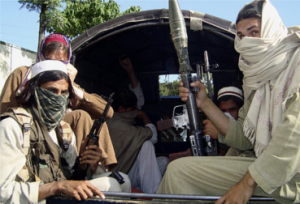
Between 2002 and 2003, soon after the US announced its global anti-terrorist campaign in Afghanistan, natives from Central Asian countries used various ways to travel to Pashtun tribal areas in Pakistan on the border with Afghanistan. In their interviews, they claimed that in those years, they received a chance to start armed conflict with the “unbelievers” in the region. The work was paid well. In Pakistan, many of them started families, married the local women and erected mud houses in small villages scattered around the Hindu Kush Mountains. Some rented accommodations from the local residents, some even put up their own camps like the Machis Camp and Dattakhel Village not far from Miramshah, the administrative centre of the North Waziristan Agency.
In 2014, the Pakistani Army Headquarters reported that “Using North Waziristan as a base, these terrorists had waged a war against the state of Pakistan and had been disrupting our national life in all its dimensions, stunting our economic growth and causing enormous loss of life and property. They had also paralyzed life within the agency and had perpetually terrorized the entire peace loving and patriotic local population.”
One of the goals of the “Strike of the Prophet’s Sword” operation, currently ongoing in the Federally Administered Tribal Areas in the North Waziristan Agency bordering Afghanistan, is to liquidate foreign militants who come from Central Asia – the Uzbeks, Tajiks, Turkmens, Uighurs, etc. Foreign militants started leaving North Waziristan in May of 2014 after the first aerial strikes by the Pakistani army, with their move gaining momentum after the terrorist attack in the Karachi Airport. They moved towards the border and towards the Afghani provinces of Khost, Paktia or Paktika.
The Pakistani security services conducted various search operations where they uncovered literature and flags belonging to various international militant organisations, including the Islamic Movement of Uzbekistan, the East Turkestan Islamic Movement, the Lashkar-i-Islam organisation, the Uighurs and others. Central Asian militants also settled in the Khyber Agency.
Militants (both local and foreign) established dozens of small plants for producing IEDs in the North Waziristan Agency and its surroundings, in the Daigan, Poikhel and Muhammadkhel regions. It was difficult for the federal forces to move into North Waziristan as many of the roads leading to its main city have been turned into mine fields.
The Utmankhel Dawar and Wazir tribal elders across various tribal areas repeatedly reassured the political administration that they will be assisting in driving out the foreign militants from their lands and will not allow them to return. In hiding from the federal army, many militants fled to the nearest forests, to the Shawal Valley and towards Southern Waziristan. Several key points of militant resistance are still active but the security services are working to dislodge any resistance. Upon fleeing, the militants are laying mines in the fields and on roads to delay the advance of the security services.
The withdrawal of the Central Asian militants from agencies bordering Afghanistan is presently occurring on a massive scale. However, the Pakistani media report that some of them plan to return to their camps or hideouts in North Waziristan. Many plan to move north, to Afghanistan and then further to various Central Asian regions. These militants who have taken part in armed fighting for a number of years also carry the aggression of Islamic extremism, which they spread everywhere they go.
The danger of spreading Islamic extremism out of Pakistan has for several years been discussed in neighbouring China. Beijing is especially worried about separatists in the north-western region of Xinjiang whose goal, according to the authorities, is to create the independent nation of Eastern Turkestan. In March of 2012, Chinese officials accused militants who were trained in Pakistan in inciting inter-ethnic strife. Governor of Xinjiang province Nur Bekri stated that “the activists and terrorists of Eastern Turkestan are connected with a thousand and one thread with the neighbouring nation”. However, the Chinese Foreign Ministry refrained from publically criticising Pakistani authorities. Muslin Uighurs make up a little over 40% of the region’s population, which amounts to 21 million people. Many of them are dissatisfied with Beijing’s state control over their culture and religion. Others claim that the fears exhibited by the Chinese authorities with respect to the threat posed by the Islamic militants in Xinjiang are exaggerated.
The rapid growth of the Chinese economy, the acute need for energy resources, the expanding spheres of influence and the fortified positions in the region all dictate that Beijing must search for additional routes to transport hydrocarbons and additional markets for its goods. In this environment, Islamabad, the “weatherproof friend”, plays the invaluable role of a transit nation for China while the military campaign in north-eastern Pakistan as well as the liquidation of Central Asian militants not only strengthens the nation’s own security, but also serves the interests of the country’s great Chinese neighbour.
Natalia Zamarayeva, PhD in History, Senior Research Fellow, Department of Pakistan at the Institute of Oriental Studies in the Russian Academy of Sciences, exclusively for the online magazine “New Eastern Outlook”.
